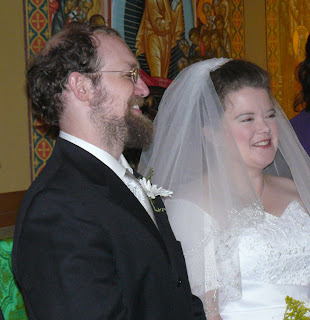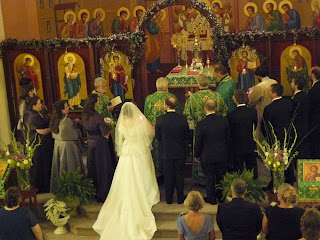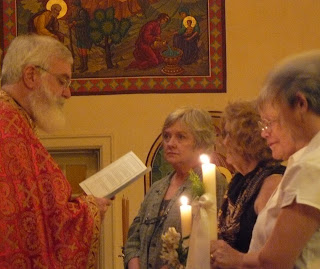>You know the commercial for the I  Phone that says, “There’s an app for that”? For some reason that ad was on my mind this weekend, when there were so many activities going on at our church, St. John Orthodox, in midtown Memphis. Please forgive me if this comes across as sacrilegious, but I couldn’t help it. Each time one of the events was happening, or about to happen, I heard this phrase in my head.
Phone that says, “There’s an app for that”? For some reason that ad was on my mind this weekend, when there were so many activities going on at our church, St. John Orthodox, in midtown Memphis. Please forgive me if this comes across as sacrilegious, but I couldn’t help it. Each time one of the events was happening, or about to happen, I heard this phrase in my head.
Need your baby blessed? There’s an app for that—it’s called Baptism. In the Orthodox Church, we baptize newborns by immersion, and that’s what happened to Brooke Elizabeth White on Saturday night.
 Her Godmother, Anne Dugan, participated in the sacrament with Brooke, who was baptized by our pastor, Father John Troy Mashburn. Many years, Brooke Elizabeth!
Her Godmother, Anne Dugan, participated in the sacrament with Brooke, who was baptized by our pastor, Father John Troy Mashburn. Many years, Brooke Elizabeth!
Sorry I didn’t get any pics of Brooke being immersed, but I only had my cell phone with me, which is why this pic is so grainy.
me, which is why this pic is so grainy.
But here’s a couple of pictures of other infant baptisms, so you can get the full image.
Need your relationship blessed? There’s an app for that—it’s called Marriage. We had two
 weddings at St. John this summer, Sally and Jason’s (the first picture was taken during the betrothal part of the ceremony, in this case, in the back of the nave)…
weddings at St. John this summer, Sally and Jason’s (the first picture was taken during the betrothal part of the ceremony, in this case, in the back of the nave)…
And this one was taken from the balcony, of the entire wedding party.
… and just a couple of weeks ago, Barbara and Mikael’s wedding. (again, I only have  pics from a cell phone, but you get the idea.) This morning Mikael and Barbara had the “removal of the wedding crowns” ceremony, which happens when the newlyweds return to church after their honeymoon. Marriage is held in high esteem in the Orthodox Christian Church, and a cause for great celebration, whether the bride and groom are young and just starting out, like Jason and Sally, or uniting later in life, like Mikael and Barbara. Many years to both couples!
pics from a cell phone, but you get the idea.) This morning Mikael and Barbara had the “removal of the wedding crowns” ceremony, which happens when the newlyweds return to church after their honeymoon. Marriage is held in high esteem in the Orthodox Christian Church, and a cause for great celebration, whether the bride and groom are young and just starting out, like Jason and Sally, or uniting later in life, like Mikael and Barbara. Many years to both couples!
Need your relationship with God blessed, as an adult convert to Orthodoxy? There’s an app for that—Chrismation.
This morning two women who have completed Catechism classes at St. John were Chrismated —Priscilla and Jill. Here they are with their sponsors, Alexandra and Laura, and with Father John Troy, our pastor. The term comes from Holy Chrism, or oil, that is used by the priest to anoint the different parts of the body, making the sign of the cross as he says, The Seal of the Gift of the Holy Spirit, and the people respond, “Seal!” The meaning of this is described by Father Michael Buben:
—Priscilla and Jill. Here they are with their sponsors, Alexandra and Laura, and with Father John Troy, our pastor. The term comes from Holy Chrism, or oil, that is used by the priest to anoint the different parts of the body, making the sign of the cross as he says, The Seal of the Gift of the Holy Spirit, and the people respond, “Seal!” The meaning of this is described by Father Michael Buben:
The anointing of the forehead signifies the sanctification of the mind, or thoughts.
The anointing of the chest signifies the sanctification of the heart, or desires.
The anointing of the eyes, ears, lips signifies the sanctification of the senses.
The anointing of the hands and feet signifies their sanctification to good works and the walk in the way of His commandments.
Other sacraments are available in the Orthodox Church.
Need a funeral and burial service for a loved one? There’s an app for that—the Orthodox funeral and burial service is one of the most beautiful and moving services in all of Orthodoxy. But it’s not the end of services for the departed. We also pray Memorial Prayers at various intervals following the death of a loved one—3 days, 40 days, monthly, yearly. So, this morning we said prayers for my Goddaughter, Mary Allison Callaway, who died eleven years ago Friday. You can read more about her death here.
 Preparing the kolliva (boiled wheat) for the memorial prayers is something I love to do. Here’s a Greek recipe that’s similar to the one I use.
Preparing the kolliva (boiled wheat) for the memorial prayers is something I love to do. Here’s a Greek recipe that’s similar to the one I use.
I’ve only found one grocery in all of Memphis that sells pelted wheat berries, like these.
The other main ingredients are raisins, nuts, honey, graham cracker crumbs, and powdered sugar.
After cooking the kolliva I took it to the church and covered it with graham cracker crumbs and powdered sugar, and placed it on a table on the solea, with three candles, representing the Holy Trinity.
 Since we are still in the season of the Holy Cross, the cross (with a piece of the actually cross on which our Lord was crucified) remains in the middle of the nave, in front of the solea, where I placed the kolliva. The juxtaposition of the instrument of Christ’s death with the memory of Mary Allison’s was somehow comforting to me this morning. As we ate the kolliva during coffee hour, and tasted its sweetness (honey and sugar) I thought, “O death, where is your sting? O grave, where is your victory?” (I Corinthians 15:55)
Since we are still in the season of the Holy Cross, the cross (with a piece of the actually cross on which our Lord was crucified) remains in the middle of the nave, in front of the solea, where I placed the kolliva. The juxtaposition of the instrument of Christ’s death with the memory of Mary Allison’s was somehow comforting to me this morning. As we ate the kolliva during coffee hour, and tasted its sweetness (honey and sugar) I thought, “O death, where is your sting? O grave, where is your victory?” (I Corinthians 15:55)
Need help with your struggles with destructive addictive or sinful behaviors, passions out of control, envy, lust, anger? There’s an app for that—the sacrament of Confession. Every Saturday night after Great Vespers (and any time during the week by appointment with the priest) Orthodox Christians may offer their brokenness and pain to God in the healing sacrament of Forgiveness, also known as Confession. This morning when Father John Troy covered the baptismal candidates with his Epitrachelion (Stole) my six-year-old Goddaughter, Sophie, asked me what he was doing. I explained that the ladies preparing for Chrismation had said their first Confession and Father John Troy was praying the prayers of Absolution for them:
“Whatever you have said to my humble person, and whatever you have failed to say, whether through ignorance or forgetfulness, whatever it may be, may God forgive you in this world and the next…. Have no further anxiety; go in peace.”
Every time I hear those words from my Father Confessor’s lips, standing before the icon of Christ, having just poured out as much of my darkness and brokenness as I have the courage to bear, I feel the air returning to my lungs and the light of Christ beginning to shine into the dark crevices of my heart. What’s that feeling? I guess it’s hope. And sometimes I actually do “go in peace” from that place.
So, why do I return again to my sins? Because, as Father John Troy reminded us in his homily on the Cross this morning, since we are created in God’s image, we have a will. We choose whether to take the easy way or the way of the Cross. We make this choice many times a day. And, as Father John said, “without the cross, we are like dead men walking.”
I guess that means that the Cross itself is an “App,” especially if you consider one of many definitions of “application”: “the act of bringing something to bear,” or this one: “a healing or curative agent.”
Still think you need an I-Phone?
10 thoughts on “>There’s an App for That”
Comments are closed.